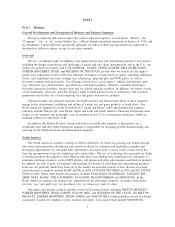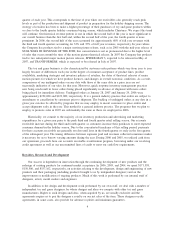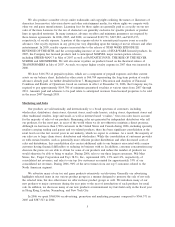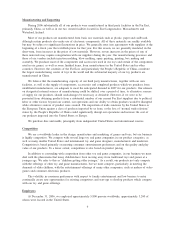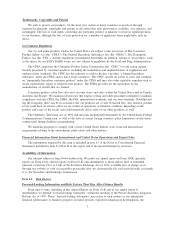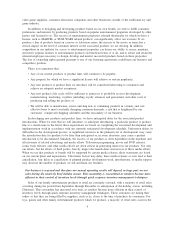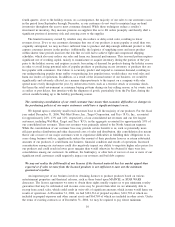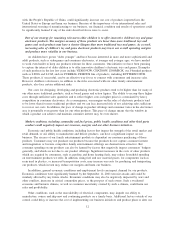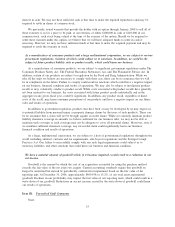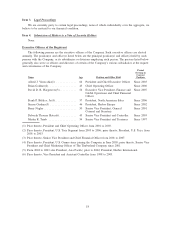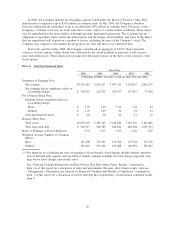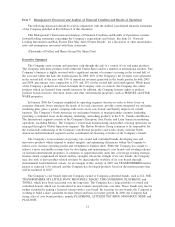Hasbro 2006 Annual Report Download - page 22
Download and view the complete annual report
Please find page 22 of the 2006 Hasbro annual report below. You can navigate through the pages in the report by either clicking on the pages listed below, or by using the keyword search tool below to find specific information within the annual report.guaranteed royalties and other licensing fees totaling approximately $164,780. Acquiring or renewing licenses
may require the payment of minimum guaranteed royalties that we consider to be too high to be profitable,
which may result in losing licenses we currently hold when they become available for renewal, or missing
business opportunities for new licenses. Additionally, as a licensee of entertainment based properties we have
no guaranty that a particular property or brand will translate into successful toy or game products.
We anticipate that the shorter theatrical duration for movie releases will make it increasingly difficult for
us to profitably sell licensed products based on entertainment properties and may lead our customers to reduce
their demand for these products in order to minimize their inventory risk. Furthermore, there can be no
assurance that a successful brand will continue to be successful or maintain a high level of sales in the future,
as new entertainment properties and competitive products are continually being introduced to the market. In
the event that we are not able to acquire or maintain successful entertainment licenses on advantageous terms,
our revenues and profits may be harmed.
Our substantial sales and manufacturing operations outside the United States subject us to risks
associated with international operations.
We operate facilities and sell products in numerous countries outside the United States. For the year
ended December 31, 2006, our net revenues from international customers comprised approximately 40% of
our total consolidated net revenues. We expect our sales to international customers to continue to account for a
significant portion of our revenues. Additionally, we utilize third-party manufacturers located principally in the
Far East, to produce the majority of our products, and we have a manufacturing facility in Ireland. These sales
and manufacturing operations are subject to the risks associated with international operations, including:
• Currency conversion risks and currency fluctuations;
• Limitations, including taxes, on the repatriation of earnings;
• Political instability, civil unrest and economic instability;
• Greater difficulty enforcing intellectual property rights and weaker laws protecting such rights;
• Complications in complying with different laws in varying jurisdictions, which laws may dictate that
certain practices which are acceptable in some jurisdictions are not acceptable in others, and changes in
governmental policies;
• Natural disasters and the greater difficulty and expense in recovering therefrom;
• Difficulties in moving materials and products from one country to another, including port congestion,
strikes and other transportation delays and interruptions;
• Changes in international labor costs and other costs of doing business internationally; and
• The imposition of tariffs.
Our reliance on external sources of manufacturing can be shifted, over a period of time, to alternative
sources of supply, should such changes be necessary. However, if we were prevented from obtaining products
or components for a material portion of our product line due to political, labor or other factors beyond our
control, our operations would be disrupted, potentially for a significant period of time, while alternative
sources of products were secured. In particular, as the majority of our toy products, in addition to certain other
products, are manufactured in the People’s Republic of China, health conditions and other factors affecting
social and economic activity in China and affecting the movement of people and products into and from China
to our major markets, including North America and Europe, and the labor and other costs of doing business in
China, could have a significant negative impact on our operations, revenues and earnings. Factors that could
negatively affect our business include a potential revaluation of the Chinese yuan, which may result in an
increase in the cost of producing products in China, increases in labor costs and difficulties in moving products
manufactured in the Far East through the ports on the western coast of North America, whether due to port
congestion, labor disputes or other factors. Also, the imposition of trade sanctions by the United States or the
European Union against a class of products imported by us from, or the loss of “normal trade relations” status
11


